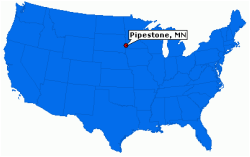Quarrying Pipestone
|
The quarrying of pipestone for use in pipes and other creations is a slow and labor intensive project that requires many hours of work and hand tools such as sledge hammers, crowbars, chisels, wedges and picks.
Pipestone is sandwiched between two layers of hard Sioux quartzite and varying depths of earth from 1-6 feet deep. Quartzite depth also can vary from 3-14 feet depending on how extensive the quarrying operation is at any given site. The pipestone seam can be 14-18 inches thick and has 4 layers. Each layer reaches a maximum thickness of 1.5-2 inches — occasionally thicker pieces can be found, but often quarriers keep these pieces for themselves. Each layer is carefully removed one layer at a time. The quarriers refer to pieces of pipestone as a seam, a portion varying in size, with a definite separation from top to bottom. |
Using the hand tools mentioned above, the quarrier will remove the rock and soil mix to expose the Sioux quartzite layers, which are visible with definite fractures and cracks. There the worker will set chisels and wedges and start to drive them into the fractures with sledgehammers, which will loosen up the large chunks until the pipestone is exposed.
The first layer of each pipestone seam is not usable for carving, but the middle layer often is useful for smaller carvings, and the bottom layer is of the best, thickest quality — and the deepest red color. Pipestone can have pink or white spots of varying size, or dark red or purple spots or swirls and pink or white lines. Each carver prefers a different type of stone for making pipes. It is also sometimes said the white spots represent where spirits have touched the rocks and left their mark. |


